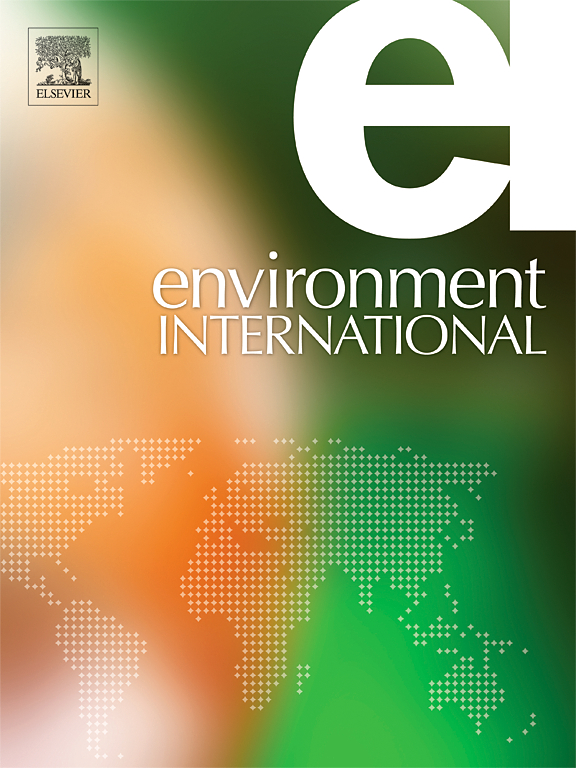中期和长期暴露于环境空气污染和温度对医疗保险受益人中第二次心血管事件住院的影响
IF 10.3
1区 环境科学与生态学
Q1 ENVIRONMENTAL SCIENCES
引用次数: 0
摘要
空气污染与心血管疾病(cvd)有关。在这项研究中,我们评估了暴露于空气污染物和环境温度是否与反复入院的不良心血管结果有关。方法:我们使用2000年至2016年医疗保险受益人的数据,研究中长期暴露于环境PM2.5、NO2、O3和温度对心肌梗死(MI)和缺血性卒中第二次入院的影响。我们从高分辨率时空模型中推导出暴露水平。我们根据人口统计、社会经济和获得医疗服务的特点进行了调整。Cox比例风险模型用于评估这些关系。我们进一步观察暴露空气污染浓度较低的影响定义为PM2.5 & lt; 9 µg / m3, NO2 & lt; 十亿分之25 ,O3 & lt; 50 ppb.ResultsPM2.5和NO2增加二招生与心肌梗死和中风的风险。对于PM2.5来说,暴露时间窗越长,影响就越明显。首次入院前一年PM2.5水平每增加µg/m3,第二次入院时心肌梗死的风险增加1.1% (95% CI: 1.0%-1.2%),卒中的风险增加0.9% (95% CI: 0.8%-1.1%)。O3对两种结果都表现出轻微的保护作用。较高的温度与中风第二次入院的风险较高有关。这些结果在较低浓度下仍然存在。结论:我们的研究表明,PM2.5和NO2暴露与心肌梗死和中风的二次入院率增加有关。较高的温度还与中风二次入院率的增加进一步相关。本文章由计算机程序翻译,如有差异,请以英文原文为准。


Effects of intermediate and long-term exposure to ambient air pollution and temperature on hospital admissions with second cardiovascular events among medicare beneficiaries
Background
Air pollution has been linked to cardiovascular diseases (CVDs). In this study, we assess whether exposure to air pollutants and ambient temperature is associated with repeated admissions with adverse cardiovascular outcomes.
Methods
We used data from Medicare beneficiaries between 2000 and 2016 to look at the effects of intermediate and long-term exposure to ambient PM2.5, NO2, O3, and temperature on second admissions with myocardial infarction (MI) and ischemic stroke. We derived exposure levels from high-resolution spatiotemporal models. We adjusted for demographic, socioeconomic, and access-to-care characteristics. Cox proportional hazards models were used to assess these relationships. We further looked at the effects of exposure at lower air pollution concentrations defined as PM2.5 < 9 µg/m3, NO2 < 25 ppb, and O3 < 50 ppb.
Results
PM2.5 and NO2 increased the hazard of second admissions with both MI and stroke. For PM2.5, the effects were more pronounced for longer exposure time windows. Each µg/m3 increase in one-year PM2.5 levels before the first admission increased the hazard of a second admission with MI by 1.1% (95% CI: 1.0%-1.2%) and stroke by 0.9% (95% CI: 0.8%-1.1%). O3 exhibited a slight protective effect for both outcomes. Higher temperatures were associated with a higher hazard of second admissions with stroke. These results persisted at lower concentrations.
Conclusion
Our study demonstrates that exposures to PM2.5 and NO2 are associated with increased rates of second admissions with MIs and strokes. Higher temperatures were also further associated with an increase in the rate of second admissions with stroke.
求助全文
通过发布文献求助,成功后即可免费获取论文全文。
去求助
来源期刊

Environment International
环境科学-环境科学
CiteScore
21.90
自引率
3.40%
发文量
734
审稿时长
2.8 months
期刊介绍:
Environmental Health publishes manuscripts focusing on critical aspects of environmental and occupational medicine, including studies in toxicology and epidemiology, to illuminate the human health implications of exposure to environmental hazards. The journal adopts an open-access model and practices open peer review.
It caters to scientists and practitioners across all environmental science domains, directly or indirectly impacting human health and well-being. With a commitment to enhancing the prevention of environmentally-related health risks, Environmental Health serves as a public health journal for the community and scientists engaged in matters of public health significance concerning the environment.
 求助内容:
求助内容: 应助结果提醒方式:
应助结果提醒方式:


